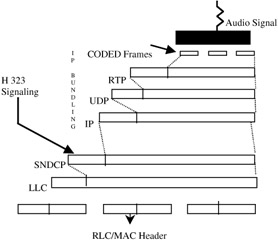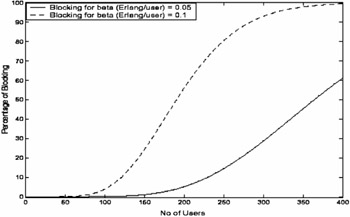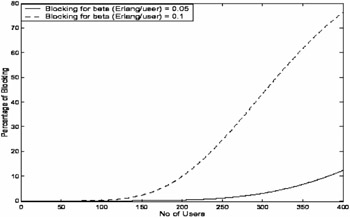7.9 Media Packet-Blocking Analysis in GPRS
7.9 Media Packet-Blocking Analysis in GPRS
The media packet transport of VoIP consists of three important functions at the terminal:
-
The analog or PCM voice signals are decoded by the codec and codec frames are delivered to the bundling function at the codec rate. For example, AMR [35] codec outputs a coded frame every 20 milliseconds, whereas G.729 [36] outputs a coded frame every 10 milliseconds. The bundling of the multiple voice frames of the coder is necessary, otherwise the overhead penalty becomes too significant.
-
The second is the selection of the Internet Protocol (IP). There are two options for IP at this stage: TCP (Transport Control Protocol) or UDP (Uniform Datagram Protocol) packet format. Most of the designs use the UDP packet protocol to transfer the media packets because the retransmission of the voice packets under BER is of no value to voice quality.
-
The next challenge is the mechanism of transporting the voice packets though the wireless access link to the Internet. The decoded UDP or TCP voice packet is to segment to the wireless link transport frame format, which depends on the wireless link standards such as GPRS, cdma2000, and IEEE 802.11 (wireless LAN), etc. The bundled coded frames are used as a payload for RTP and header for UDP and IP are added to construct a GPRS packet. The GPRS packet is then compressed by SNDCP and a LLC PDU is formed. This GPRS LLC PDU is broken down to GPRS MAC/RLC [37] layer frames that are transmitted every 20 milliseconds. The block diagram of these functions for GPRS is shown in Figure 7.13.

Figure 7.13: Voice payload design of GPRS VoIP.
Thus, there are multiple design parameters in this voice payload assembly problem. We consider the case of a system using GPRS and UDP for transfer of voice packets. Let
| r | = | Rate of voice coding in kilobits per second. |
| f | = | Frame time of voice coding in milliseconds. |
| F | = | Frame size of voice codec in bytes. |
| Hip | = | IP header in bytes (normally 20 bytes). |
| HUDP | = | UDP header in bytes (normally 8 bytes). |
| HCTP | = | CTP header in bytes (normally 12 bytes, can be compressed to 2 to 4 bytes). |
| HGPRS | = | GPRS header in bytes (normally 10 bytes). |
| β | = | Bundling factor. This bundling will result in additional delay on the voice path. |
GPRS packet size:
-
PGPRS = F.β + [Hip + HUDP + HCTP + HGPRS]
The overhead of this conversion of voice frames on UDP packets is 100[Hip + HUDP + HCTP +HGPRS]/PGPRS (percent).
Figure 7.14 shows the overhead penalty of three different voice coders: AMR at 4.5 kbps, G.729 at 8 kbps, and GSM voice coder at 13.2 kbps. Depending on the different bundling parameter, additional delay will result in the system, although the overhead penalty will be reduced. The delay curve is linear to bundling factor, whereas the percent overhead reduction is high at bundling two or three codec frames. The VoIP designer will select the delay and the overhead penalty to get the appropriate value for the end-to-end delay of the service.

Figure 7.14: Overhead vs. delay due to packet bundling.
The codec voice packets after being bundled are segmented to fit into the GPRS frame size. The actual transmission of the packets through the GPRS channel in the upstream involves two functions. In the uplink direction, the GPRS traffic channel request is sent to the GPRS base station using uplink random access channel. The BSC transmits a notification to a mobile station terminal indicating temporary buffer flow (TBF) allocation. TBF allocation is basically a physical connection used to support the transfer of blocks. Each TBF connection is assigned one TFI (temporary flow identifier). TFI is included in each of the transmitted radio blocks so that multiplexing of different mobile stations can be done on the same packet data channel. As a matter of fact, GPRS uses dynamic bandwidth allocation. When a user needs more bandwidth, physical connection is established by the interaction between the mobile station and the base station to allow the mobile station to send the data in the uplink direction. This physical connection is considered TBF allocation. Every time the mobile station wants to send the data, it must establish this physical connection with the base station and tear down the connection at the end of the transmission. This whole process is time consuming, especially when the transmitting packet is too small, and the delay incurred by the TBF increases the mean delay. To support the packet-switched principle of GPRS, resources of the one packet data channel are assigned only temporarily to one mobile station.
In GPRS, uplink and downlink are carried out on different 200 kHz channels. The BSC handles the resource allocation in downlink as well as in uplink. All the packets are originated from the BSC (downlink), no concurrent access on one packet data channel can occur. While in the uplink, more than one mobile station can try to get hold of one packet data channel at the same time. To avoid the access conflict in the uplink direction, the BSC transmits the USF associated with each of the radio blocks in the downlink direction (USF identifies each of the mobile stations distinctly), indicating which mobile station has rights to send the data in the corresponding uplink block.
The PCU (process control unit) of the GPRS performs the allocation of capacity of the traffic channel for transfer of the voice packets to the base station. Because of the sharing of multiple GPRS terminals by the same GPRS traffic, the VoIP will encounter blocking when it requests the service from the GPRS system. This blocking depends on the number of active GPRS terminals in the cell and the intensity of the voice packets generated by the active voice terminals. The channel blocking probabilities are determined by the two-stage modeling technique. In the first stage, the probability of the number of active sources in the system is determined, and in the second step, out of these active terminals, probabilities of numbers of simultaneous traffic bursts generated by the terminals are determined. The probabilities of the simultaneous traffic bursts of the sources are modeled by considering the on-off burst source model of the individual source. Consider the case of an only-VoIP terminal in a GPRS system.
7.9.1 VoIP Traffic Blocking
The model of the GPRS VoIP user in a cell is considered as a finite-state Markov process with quasirandom arrival. The idle-state arrival rate decreases and departure rate increases, as more users are in the system. This is the traditional Engset Model [38]of telephony. This model will give the state probability of active users in the system. The actual design of the system will include a threshold of maximum number of users that the system will allow to enter (new users and handoff users). Let
| n | = | Total number of VoIP terminals in the cell coverage area. |
| a | = | Arrival rate of the free VoIP traffic source. |
| 1/μ | = | Mean service time of one VoIP source during active voice session. |
| Pi | = | Probability of i-VoIP traffic source active in the system. |

where β = α/μ.
The accepted VoIP session will generate the voice traffic bursts depending on the coding speed and the bundling mechanism used in the system. The GPRS uses multiple coding schemes. Four GPRS coding schemes are proposed: CS-1 (9.05 kbps), CS-2, CS-3, and CS-4 (21.4 kbps). The CS-1 scheme has the highest error-correction capability, whereas CS-4 has no error-correction capability. In the typical GPRS system, most likely only CS-1 and CS-2 will be used. CS-2 has a user data rate of 13.4 kbps with some error-correcting capability. Any GPRS terminal can initiate a session and the talk bursts can be modeled as an on-off source. We can divide the entire holding time in the two regions: user is in on-state when it is active, and in off-state when there is no talk burst and a silent period during the conversation. [39], [40]
So from "i" users in the system, the probability that "k" users will be in on-state is given as
![]()
where ρ =probability of being in on-state in one second (assuming the same for all the users), and 1 - ρ= probability of being in off-state.
The joint probability that the i users are active and k users are in on-state is given by Pi Pik. Hence for a GPRS system with 8 slots in 200-kHz spectrum and assuming each active burst is using one slot at a time, the probabilities of burst level blocking of the system is given by
![]()
The PCU of the GPRS performs the allocation of the capacity of the traffic channel for transfer of the voice packets to the base station. The GPRS traffic channel is shared by the multiple voice sources within the cell-site coverage area. Because of this sharing of common GPRS resource by multiple GPRS terminals, the VoIP will encounter blocking. This blocking depends on the number of active GPRS terminals in the cell and intensity of the voice packets generated by the active voice terminals. The blocking performance with respect to number of users is shown in Figure 7.15. The system is using AMR coding with a bundling factor of 3 and a UDP transport mechanism with header compression and a GPRS CS-2 coding scheme. Here we have assumed that the VoIP terminal generates 50 milli-Erlang and 100 milli-Erlang of traffic and a burst occupancy of 0.5.

Figure 7.15: GPRS burst level blocking without silent detection.
The burst level blocking performance can be improved by including the silent detection mechanism in the codec. In a two-way conversation, when the codec detects the silent period, the average number of talk bursts will reduce and thus bring additional capacity in the radio link. Normally, a user talks about 50 percent of the time and listens the remaining 50 percent of the time. If we use a 40-percent savings in capacity due to the unidirectional flow, more users can be supported in the system, as shown in Figure 7.16. Assuming a very low burst level blocking, the system can support more than 200 users for 50 milli-Erlang per user. The actual 200 kHz GSM system channel may not support more than 100 50-milli-Erlang users. There is an opportunity to gain voice traffic capacity in the GPRS VoIP.

Figure 7.16: GRPS burst level blocking with silent detection
[35]GSM 06.10, Digital Cellular Telecommunications System (Phase 2+): Adaptive Multi-Rate (AMR) Speech Transcoding, Version 7.1.0, Release 1998.
[36]International Telecommunications Union, Coding of Speech at 8 kbits/sec Using Conjugate-Structure Algebraic Code-Excited Linear-Predictive (CS-ACLEP) Coding, Recommendation H.729, Telecom Standardization Sector, Geneva, Switzerland, Mar. 1996.
[37]GSM 04.60, Digital Cellular Telecommunications System (Phase 2+): General Packet Radio Service (GPRS): Radio Link Control/Media Access Control (RLC/MAC) Protocol, July 1998.
[38]Kleinrock, L., Queueing Systems, Vol. 1: Theory, John Wiley and Sons, New York, 1975, pp. 99–110.
[39]Kwon, T.T. et al., Mobility management for VoIP service: mobile IP vs. SIP, IEEE Wireless Communications, Special issue on IP Multimedia in Next-Generation Mobile Networks, Apostolis, S. and Merakos, L., Guest Eds., Oct. 2002.
[40]Westberg, L. and Lindqvist, M., Realtime Traffic over Cellular Access Networks, IETF draft-westberg-realtime-cellular-01.txt, Oct. 1999.
EAN: 2147483647
Pages: 239